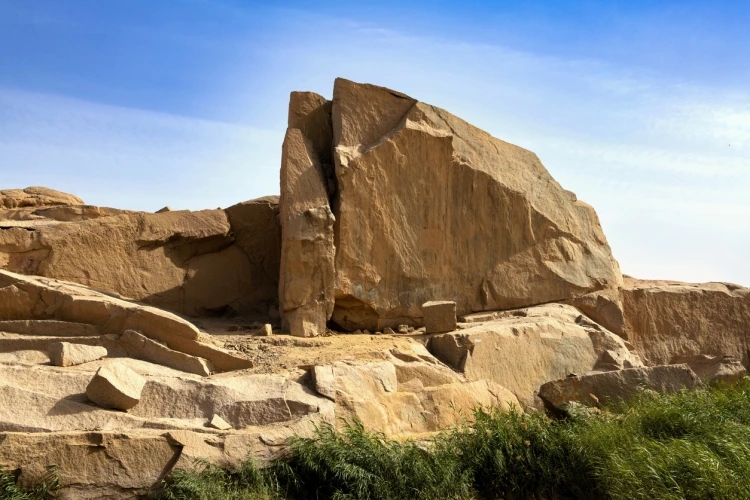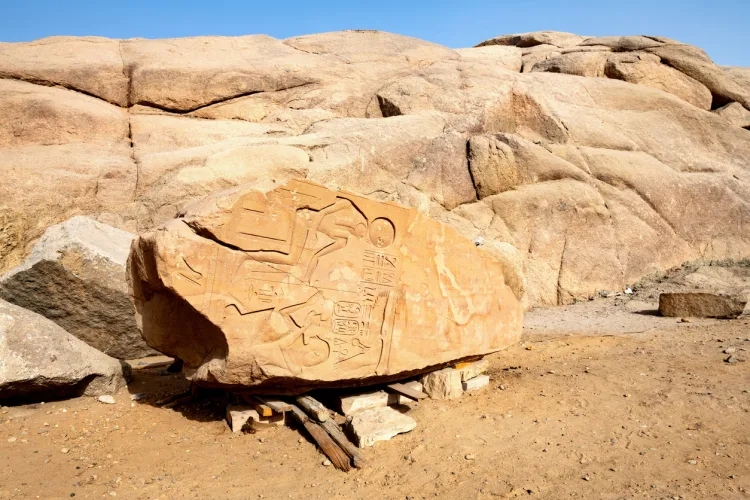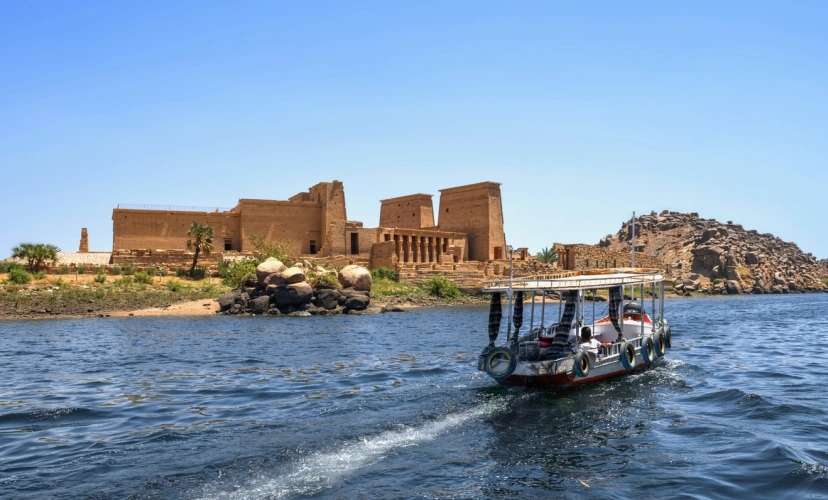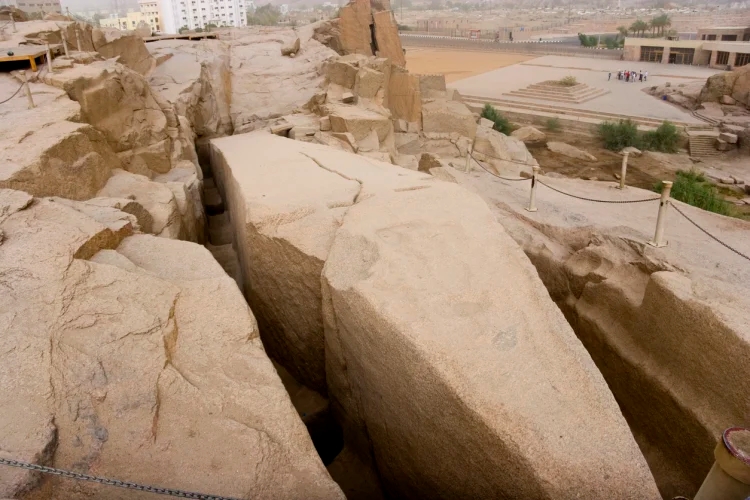
The Unfinished Obelisk stands as a testament to the grandeur and ambition of ancient Egyptian civilization. Located in the northern region of the stone quarries of Aswan, this incredible relic provides unique insight into the techniques of ancient stone masons. The obelisk was intended to be the largest of its kind, towering over all others with an estimated height of approximately 42 meters (about 137 feet) and a weight of nearly 1,200 tons. However, it never reached completion, leaving behind an archaeological mystery that continues to fascinate historians and tourists alike.
The Unfinished Obelisk is situated in the northern quarries of Aswan, a city renowned for its rich history and stunning landscapes. Aswan, located in southern Egypt, has been a pivotal trading hub since ancient times, known for its strategic position along the Nile River. The quarries of Aswan are particularly famous for their high-quality granite, which was extensively used in the construction of temples, monuments, and obelisks throughout Egypt.
The history of the Unfinished Obelisk dates back to the reign of Queen Hatshepsut, one of Egypt's most successful pharaohs. It is believed that she commissioned the obelisk during the 18th Dynasty, intending it to be a monumental addition to the Karnak Temple in Luxor. The ambitious project, however, was never completed due to a critical flaw discovered in the granite.
Though never completed, the Unfinished Obelisk remains a valuable historical artifact. Cracks in the granite led to its abandonment, revealing the high standards and precision of ancient Egyptian builders. This decision reflects the challenges of working with massive stone using limited tools and the remarkable skill of the craftsmen. The obelisk’s unfinished state offers insight into the techniques, priorities, and ingenuity of a civilization known for its architectural mastery. Today, it stands as a powerful reminder of ancient Egypt’s ambition and enduring legacy.

In ancient Egypt, obelisks held significant religious and cultural importance. They were often erected in pairs at the entrances of temples and were believed to represent the rays of the sun, symbolizing a connection between the earthly and the divine. The Unfinished Obelisk, despite never being completed or erected, embodies this spiritual symbolism, reflecting the profound religious beliefs of the ancient Egyptians. Visitors on Egypt tours can witness this powerful symbol firsthand, gaining deeper insight into the spiritual heritage of ancient Egypt.
The Unfinished Obelisk stands as a testament to the power and ambition of the pharaohs, especially Queen Hatshepsut, who likely intended it to surpass all others. Its massive scale highlights the ruler's ability to command vast resources and labor. The site also reveals the advanced technological and artistic skills of ancient Egypt, showcasing their expertise in engineering, mathematics, and craftsmanship. Today, it remains a powerful symbol of Egypt’s enduring cultural legacy.
The quarrying process for the Unfinished Obelisk was a complex and labor-intensive operation. Ancient Egyptian craftsmen employed a range of techniques to extract large blocks of stone from the granite bedrock. The process began with the marking of the desired shape on the rock surface, followed by the creation of trenches around the block using stone tools, such as dolerite balls, which were used to pound the granite.
Workers inserted wooden wedges into carved trenches and soaked them with water, causing the wood to expand and crack the granite along planned lines. This method demanded precision and intense labor. Once freed, the stone would be smoothed and polished with specialized tools. The Unfinished Obelisk offers a rare glimpse into these techniques, showcasing the skill and ingenuity of ancient Egyptian stonemasons.

The primary reason for the abandonment of the Unfinished Obelisk was the discovery of a significant crack in the granite during the quarrying process. This flaw would have compromised the structural integrity of the obelisk, making it unsuitable for erection. The decision to abandon the project reflects the high standards of quality and precision that were characteristic of ancient Egyptian construction.
The massive scale of the Unfinished Obelisk made transport and erection extremely challenging, even with advanced ancient techniques. A flaw in the stone, combined with these logistical difficulties, likely led to the project's abandonment. Political and economic factors,such as leadership changes, evolving religious priorities, or limited resources,may have also influenced the decision. The site reflects the complex forces shaping ancient Egypt’s history.
The Unfinished Obelisk is a remarkable example of ancient Egyptian architecture, despite its incomplete state. The sheer size of the obelisk, with an estimated height of 42 meters (137 feet), would have made it the largest ever created. Its design follows the traditional form of obelisks, characterized by a tall, slender shaft with a pyramidal top, known as a pyramidion.
The visible chisel marks on the Unfinished Obelisk offer rare insight into the tools and techniques of ancient Egyptian craftsmen, showcasing their precision and skill. Its unfinished state allows a unique look into the stone-shaping process. Located within the original quarry, the site also reveals broader quarrying methods, with trenches and tool marks still present. This remarkable site highlights the engineering brilliance of a civilization that continues to inspire.

Today, the Unfinished Obelisk is a popular tourist destination, drawing visitors from around the world who are eager to explore its historical and architectural significance. The site offers a unique opportunity to connect with the past and gain a deeper understanding of the ingenuity and skill of ancient Egyptian craftsmen. Visitors can walk around the obelisk, examining the detailed markings and learning about the quarrying processes that shaped its creation.
Guided tours offer rich insights into the Unfinished Obelisk and often include nearby sites like Philae Temple and the Aswan High Dam, creating a full cultural experience. The obelisk is a key highlight, immersing visitors in the engineering and history of ancient Egypt.
Beyond its historical value, the Unfinished Obelisk offers breathtaking views of the desert landscape, perfect for photography and exploration. Its blend of natural beauty and ancient mystery makes it a must-visit for anyone exploring the wonders of ancient Egypt.
The best time to visit the Unfinished Obelisk is during the cooler months from October to April. During this period, temperatures in Aswan are more comfortable, making it easier for visitors to explore the site and its surroundings without the intense heat of the summer months. The pleasant weather allows for a more enjoyable and immersive experience, enabling travelers to fully appreciate the historical and natural beauty of the region.
Visiting the Unfinished Obelisk in the early morning or late afternoon offers ideal lighting for photography and a peaceful atmosphere. The soft glow of sunrise or sunset enhances the site’s details and desert backdrop. For a fuller experience, travelers can combine their visit with nearby attractions like Philae Temple and the Nubian Museum, gaining deeper insight into Aswan’s rich heritage. Strategic timing ensures a memorable and enriching visit.
1. Largest Known Obelisk: If completed, the Unfinished Obelisk would have been the largest known obelisk in ancient Egypt, surpassing any other in height and size.
2. Queens Commission: It was commissioned by Queen Hatshepsut, one of the few female pharaohs of Egypt, known for her ambitious building projects.
3. Visible Tool Marks: The obelisk provides a unique opportunity to see the tool marks left by ancient stone masons, offering insights into their techniques and tools.
4. Educational Tours: The site offers guided tours which provide visitors with detailed information about the history and significance of the obelisk.
5. Cultural Heritage Site: The Unfinished Obelisk is part of Aswan's rich cultural heritage, contributing to its designation as a UNESCO World Heritage site.
6. Accessibility: Located near the city center of Aswan, the site is easily accessible and is a popular attraction for both local and international tourists.

The Unfinished Obelisk is one of ancient Egypt’s most fascinating relics, offering insight into the engineering skills and cultural values of the time. Its incomplete state reveals rare details of ancient quarrying, while its immense scale reflects the ambition of the pharaohs. Visiting the site connects travelers to the past, showcasing Egypt’s historical depth. As a tourist attraction, it offers a unique chance to witness ancient ingenuity firsthand. Preserving the obelisk is vital to protecting Egypt’s heritage, ensuring future generations can continue to learn from this remarkable site. A must-see for history lovers and curious travelers alike.
Q1. What is the Unfinished Obelisk?
The Unfinished Obelisk is an ancient, massive granite monument in Aswan, Egypt, that was abandoned due to cracks discovered during its quarrying.
Q2. Why was the Unfinished Obelisk never completed?
Workers found large cracks in the granite, making the obelisk structurally unsound, so the project was halted.
Q3. How big is the Unfinished Obelisk?
If completed, it would have been about 42 meters (138 feet) long and weighed approximately 1,200 tons, making it the largest known ancient obelisk.
Q4. Can I see the chisel marks on the Unfinished obelisk?
Yes, the unfinished state exposes detailed chisel marks, offering insight into ancient craftsmanship and quarrying methods.
Q5. Where is the Unfinished Obelisk located?
It is located in the northern region of the Aswan quarries in southern Egypt.
Q6. Are guided tours available to visit the Unfinished Obelisk?
Yes, guided tours are offered, often combined with visits to nearby attractions like the Philae Temple and Aswan High Dam.
Q7. What makes the Unfinished Obelisk historically significant?
It reveals the engineering challenges and artistic skills of ancient Egypt and provides a rare glimpse into quarrying techniques.


© Copyright 2025 Get Egypt Tour. All rights reserved.